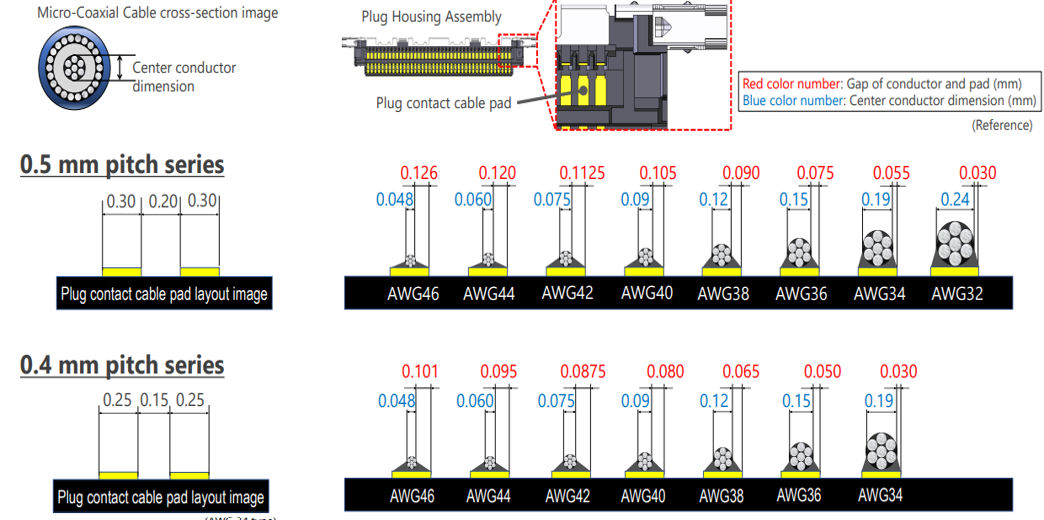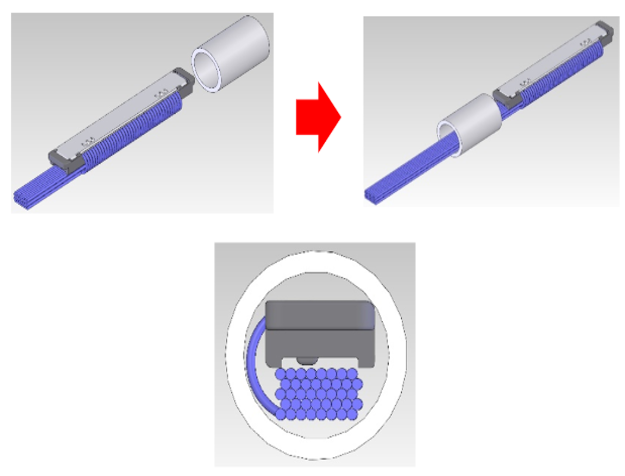コネクタのための利用可能な面積 | 細線同軸・Twinaxialコネクタ
インターフェースのチャンネル数、必要なピン数、各ピンの間隔、プラグとコネクタの許容嵌合幅、長さ、プロファイルの高さによって、使用すべきコネクタのタイプが決まります。また、PCB上の最大利用可能面積とコネクタの位置により、リセプタクルとプラグのハーネスアッセンブリの取り付け形状が決まります。I-PEXは、CABLINE®高速コネクタシリーズで、水平、ライトアングル、垂直実装構成、さまざまなサイズとピン数のコネクタを提供しています。

垂直実装タイプのコネクタは、主にケーブルと基板の接続に使用され、PCB上の任意の場所、通常はICピンの近くに配置することができます。垂直実装コネクタは、特に基板対基板のブラインド嵌合アプリケーションにおいて、プラグとリセプタクルの適切な嵌合のための位置合わせに役立つガイド設計も利用可能です。一方、水平実装タイプのコネクタは、一般的に基板の端に配置され、基板上のコネクタにケーブルアッセンブリを適切に嵌合するために、コネクタの周囲にクリアランスが必要です。水平コネクタは、カメラ、スピーカー、ディスプレイ、テストボードなどの周辺システムへのIO接続のために、信号トレースが基板の端まで配線されている基板に適しています。一般的に水平コネクタは、下の図2に示すように、X軸方向に長い有効嵌合長を持つことができるため、垂直コネクタに比べてプロファイルの高さを低くすることができます。
 垂直コネクタの接触ワイピング長さ
垂直コネクタの接触ワイピング長さ有効嵌合長もコネクタ保持力に重要な役割を果たします。特に、携帯電話、タブレット、ゲーム機などと言ったハンドヘルド型のシステムでは、落下や転倒の可能性があるため、有効嵌合長が短く、低背の垂直マウントコネクタの嵌合接続では、接続が損なわれる可能性があります。このような用途では、上部にメカニカルロックとクッション材を備えたコネクタが嵌合保持力を補うのに役立ちます。
コネクタのピンピッチ、すなわちコネクタのピン間の間隔は、ハーネスアッセンブリに使用できる細線同軸ケーブルと Twinax ケーブルのサイズを決定します。中心導体径が大きいケーブルは、中心導体径が小さいケーブルに比べて挿入損失が小さくなります。ピンピッチの狭いコネクタは、ピンピッチの広いコネクタに比べ、減衰の大きい細線同軸ケーブルやTwinaxケーブルに対応できます。ピンピッチの広いコネクタはより太いケーブルに対応できるため、ハーネスの挿入損失が小さくなります。したがって、ピンピッチが広いほど、より太いケーブルサイズを選択し、アプリケーションでの損失を最小限に抑えることができます。参考までに、0.5mmピッチと0.4mmピッチのコネクタのワイヤゲージとパッドサイズの比較を以下に示しています。

I-PEXコネクタの小型化とユニークなデザインは、これらのコネクタをはるかに小さなスペースに通すことを可能にします。これらのコネクタは下図に示すように、コネクタやケーブルを損傷することなく、限られたスペースのヒンジ部品に通すことができます。細線同軸ケーブルの高い柔軟性と最小限のコネクタ幅により、ノートパソコンや携帯電話の折りたたみ式スクリーンのような製品のヒンジにハーネスを通すことができ、スクリーンの折りたたみと展開の回数を増やすことができます。CABLINEハーネスアッセンブリのヒンジ部用途アプリケーションでの使用方法の詳細については、以下のリンクと画像をクリックしてください。

